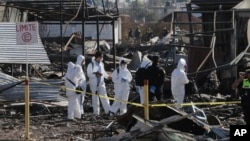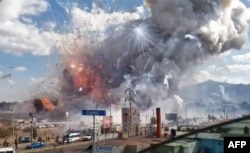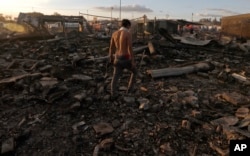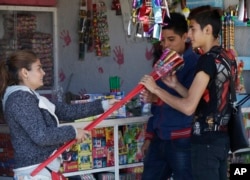Relatives of workers at a fireworks market flattened by a deadly chain-reaction explosion searched hospitals for loved ones Wednesday as attention focused on apparent lax security that allowed vendors to display their dangerous wares in the passageways between stalls.
Late Wednesday, the state of Mexico, where the San Pablito Market is located, updated its list of dead to 33, a figure also announced by state Interior Secretary Jose Manzur in a local radio interview. About 46 people remained hospitalized. Ten of the injured were minors, including one girl with burns over 90 percent of her body.
Juana Antolina Hernandez, who has run a stand for 22 years in San Pablito next to one operated by her parents, escaped the market in a mad dash when the explosions began Tuesday afternoon. The following day she was one of the disconsolate residents waiting outside a local morgue.
“I can’t find my father, and my mother is very badly burned,” said Hernandez, 49. “I am waiting here for them to tell me if my father is here, but up to this point, nothing.”
Full of fireworks, shoppers
San Pablito was especially well stocked for the holidays and bustling with hundreds of shoppers when the blast reduced the market to a stark expanse of ash, rubble and the scorched metal, casting a pall over the Christmas season. Dramatic video of the explosion showed a towering plume of smoke that was lit up by a staccato of bangs and flashes of light, the third such incident to ravage the market on the northern outskirts of Mexico’s capital since 2005.
Refugio Leon, who spent years working at the market and whose family ran seven stalls there, said vendors commonly stacked displays of bottle rockets and firecrackers outside their establishments in the passageways — even though the rules supposedly forbade putting merchandise in what was supposed to be a safety buffer to prevent chain-reaction explosions.
“Everybody did it,” Leon said, speculating that it may have played a role in the rapid spread of the explosions.
Video and photos of the stalls from previous years showed concrete-block enclosures with open dirt passageways between them; later photos showed the passageways filling up with fireworks and awnings.
Cause still unknown
Officials in Mexico State, which borders Mexico City, said it was too early to identify a cause of the massive series of blasts.
On December 12 the city of Tultepec, where the market is located, issued a statement calling San Pablito “the safest market in Latin America.” It said 100 tons of fireworks were expected to be sold during the high season, which runs from August to New Year’s.
The city quoted Juan Ignacio Rodarte Cordero, the director of the state’s Fireworks Institute, as saying “the stalls are perfectly designed and with sufficient space between them to avoid any chain of fires.” City officials said the stalls were equipped with trained personnel, sand, shovels and fire extinguishers.
But during a recent visit to the market, little of that safety equipment could be seen. And when Tuesday’s explosion began, vendors and customers didn’t have time to look for it — or even, in many cases, to run.
‘Only thing you can do is run’
In a fireworks market in Jaltenco, about 30 minutes away from the San Pablito market, business was slow Wednesday.
Rosa Maria Gonzalez, 47, indicated that her stand was 12 meters from the next nearest ones and said she believed that San Pablito’s passageways were narrower and more cluttered.
Gonzalez said she had a permit and met all of the other required safety measures with a bucket of sand and bucket of water at the ready. But she conceded it likely would not make a difference.
“When there is really an accident there isn’t time for anything,” Gonzalez said. “I’m not going to look for the sand, if it begins to go off the only thing you can do is run and wait until it all goes out.”
The president of the leftist Democratic Revolution Party, Alejandra Barrales, noted that fireworks accidents take place regularly including four this year alone.
“This demonstrates the lack of care and attention not just here but in the whole state,” Barrales said in a statement.
Bodies difficult to identify
Mexico State chief prosecutor Alejandro Gomez said some of the dead were so badly burned that neither their age nor their gender could be immediately determined, and that DNA tests would be needed. He said the toll could rise because 12 people were listed as missing and some body parts were found at the scene.
A list of the nine bodies identified so far included a 3-month-old boy and a 12-year-old girl. Gomez said a total of seven male minors were among the dead.
Tultepec Mayor Armando Portuguez Fuentes said late Tuesday that the manufacture and sale of fireworks is a key part of the local economy. He added that it is regulated by law and under the “constant supervision” of the Defense Department, which oversees firearms and explosives.
“This is part of the activity of our town. It is what gives us identity,” Portuguez said. “We know it is high-risk, we regret this greatly, but unfortunately many people’s livelihoods depend on this activity.”
Manzur, the interior secretary, said 30,000 people make a living from fireworks in Tultepec and the trade had been going on there for two centuries.
“Everything is gone,” said Hernandez, the woman at the morgue, for whom the market represents a family business passed down from one generation to the next. “I know we lost everything, but I am going to start over.”
Two similar fires engulfed the San Pablito Market in 2005 and 2006, touching off chain-reaction explosions that leveled hundreds of stalls in each incident.
Deadly fireworks explosions have also occurred elsewhere in Mexico: In 2002, a blast at a market in the Gulf coast city of Veracruz killed 29; in 1999, 63 people died when an explosion of illegally stored fireworks destroyed part of the city of Celaya; and in 1988, a fireworks blast in Mexico City’s La Merced market killed at least 68; and in 2013 a rocket struck a truck loaded with fireworks for a religious procession in Tlaxcala state, killing 17 people.










